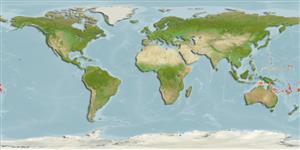>
Gobiiformes (Gobies) >
Gobiidae (Gobies) > Gobiinae
Etymology: Trimma: Greek, trimma, -atos = something crushed (Ref. 45335); anthrenum: From the Greek word 'anthrene', a wild bee, wasp or hornet, referring to its aposematic coloration of yellow with black stripes..
More on author: Winterbottom.
Environment: milieu / climate zone / depth range / distribution range
Ecologia
marino associati a barriera corallina; distribuzione batimetrica 5 - 76 m (Ref. 57544). Tropical
Distribuzione
Stati | Aree FAO | Ecosystems | Presenze | Point map | Introduzioni | Faunafri
Western Pacific: Fiji and Tonga.
Size / Peso / Age
Maturity: Lm ? range ? - ? cm
Max length : 2.0 cm SL maschio/sesso non determinato; (Ref. 57544); 2.0 cm SL (female)
Spine dorsali (totale): 7; Raggi dorsali molli (totale): 8-9; Spine anali 1; Raggi anali molli: 7 - 9. Diagnosis: Characterized by the presence of scales in the predorsal midline; second and third dorsal spines either slightly or not elongate; an unbranched fifth pelvic fin ray; both interorbital and postorbital trenches moderately well developed; and the absence of opercular scales. Scale margins of preserved specimens are very finely outlined with melanophores across the top half of the body, which is otherwise almost devoid of visible pigment cells. When alive, it has a yellow body, and the iris has a pair of blue and black triangles with their bases against the anterior and posterior margins of the pupil (giving the pupil a slit-like appearance), the posterior triangle continues anteroventrally around the pupil margin. Both living and preserved specimens have a dark basal stripe in the medial fins and a blaze of brown pigment on the upper part of the pectoral-fin base (Ref. 57544).
Life cycle and mating behavior
Maturità | Riproduzione | Deposizione | Uova | Fecundity | Larve
Winterbottom, R., 2006. Two new species of the gobiid fish Trimma from the coral reefs of the western Pacific Ocean (Pisces; Perciformes; Gobioidei). Zootaxa 1331:55-68. (Ref. 57544)
IUCN Red List Status (Ref. 130435)
Threat to humans
Harmless
Human uses
Informazioni ulteriori
Nomi ComuniSinonimiMetabolismoPredatoriEcotossicologiaRiproduzioneMaturitàDeposizioneSpawning aggregationFecundityUovaEgg development
Age/SizeAccrescimentoLength-weightLength-lengthLength-frequenciesMorfometriaMorfologiaLarveDinamica popolazioni larvaliReclutamentoAbbondanzaBRUVS
BibliografiaAcquacolturaProfilo di acquacolturaVarietàGeneticaElectrophoresesEreditarietàMalattieElaborazioneNutrientsMass conversion
CollaboratoriImmaginiStamps, Coins Misc.SuoniCiguateraVelocitàModalità di nuotoArea branchialeOtolithsCervelliVista
Strumenti
Special reports
Download XML
Fonti Internet
Estimates based on models
Preferred temperature (Ref.
123201): 25.4 - 28.7, mean 27.3 °C (based on 124 cells).
Phylogenetic diversity index (Ref.
82804): PD
50 = 0.5000 [Uniqueness, from 0.5 = low to 2.0 = high].
Bayesian length-weight: a=0.01023 (0.00477 - 0.02194), b=3.02 (2.84 - 3.20), in cm total length, based on LWR estimates for this (Sub)family-body shape (Ref.
93245).
Resilienza (Ref.
120179): Alto, tempo minimo di raddoppiamento della popolazione meno di 15 mesi (Preliminary K or Fecundity.).
Fishing Vulnerability (Ref.
59153): Low vulnerability (10 of 100).
